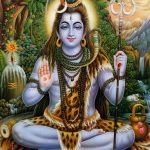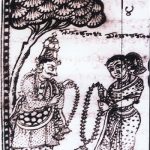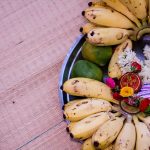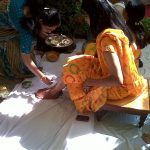The unique Konkani culture adds its special flavor to the Konkani wedding rituals. To know more about the Konkani wedding rituals as well as the pre-wedding formalities, read on.
Matching Of Horoscopes
The families of the prospective bride and groom look for a suitable match among the other members of their community. The families exchange horoscopes and a Pandit compares the charts and matches them. If the horoscopes match and both the families are happy with the match, the Pandit fixes an auspicious date and time (Muhurat) for the wedding.
Pre-Wedding Nandi Pooja
The bride and her family perform a Nandi Pooja at least ten days before the wedding. They prepare a plate filled with rice and place four coconuts on it. It is the custom for married women, the bride’s mother, the bride, and her younger sister to participate in this ceremony. The pooja requests the blessings of the Gods as well as ancestors on the upcoming nuptials. The bride receives ceremonial glass bangles that she then wears throughout the Konkani wedding rituals.
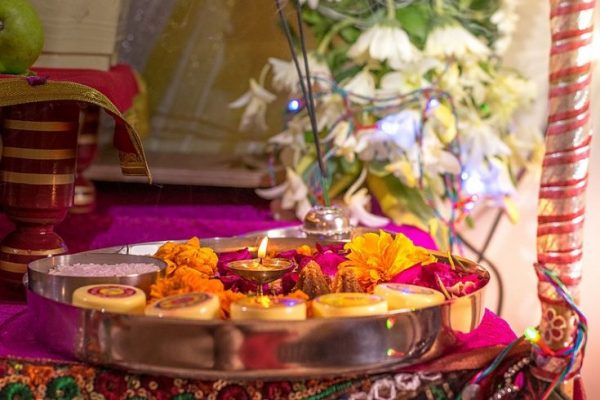
Prathna
The bride’s and groom’s families respectively have a Prathan ceremony at their homes for a promising start to the Konkani wedding rituals.
Yeduru Kansani
The bride’s brother formally invites the groom’s family to the Yeduru Kansani rituals. The bride’s family welcomes the groom to the venue of the ritual. The womenfolk of both the families arrange auspicious items on different Thalis (round plates). Some of the items are Sasha Poleru, betel leaves, flowers, arecanut, rose water sprinkler, turmeric, Kumkum, Akshat, and a Kalash. The Kalash is a round pot called the Kalas Kannasi decorated with a gold chain and also a mirror. The plate is carried by the sisters of the bride and the groom, respectively.
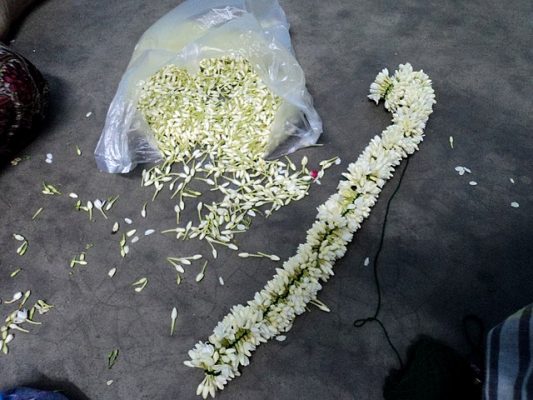
The families exchange the plates that contain flowers, turmeric, and other items. Then, the family members pick up a handful of Akshat, go around the Kalash Kannadi, and look at their reflections in the mirror. Rosewater is sprinkled on all present. The bride’s father gifts the groom with a coconut.
Phool Mudi
The bride’s parents give a Muddi (ring) to the groom. They then give the groom and his brother (Dheddo) new clothes and perform Arthi. The groom’s parents give the bride flowers. The groom’s mother gives the bride a saree which she will then wear for other rituals.

The Wedding Day
Uddida Muhurat
Uddida or black gram dal is very auspicious. The bride and the groom respectively grind this pulse on a stone grinder. The bride and the groom later eat idlis made from this flour. In older times, the grinding ceremony would be held at the respective homes of the bride and the groom. But, in modern times, the grinder is kept at the wedding venue, and the bride and the groom take turns at it.
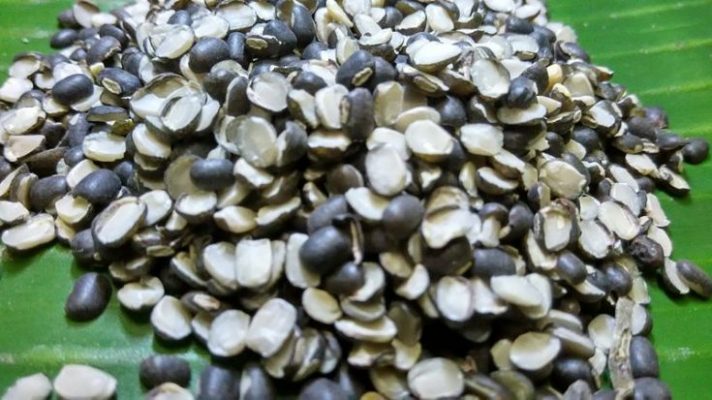
Ghadde Udda
Traditionally, the bride and her female relatives fill five pots with water from a well. This custom is not always followed in modern times as wells are not always present at the wedding venue. After this, the bride is dressed in a Navarra saree.

Kashi Yatra
This is a common ritual in most South Indian weddings. The groom playfully grabs an umbrella and pretends to be abandoning the pending nuptials in favor of going to Kashi for a Sanyasi life. The bride’s father convinces him to stay and get married.
Mandap Pooja
The bride’s mother leads the grandly dressed bride to the wedding Mandap. She wears a Nauvari Saree and a white stole. The bride and her mother perform pooja for the Mandap. After the Mandap Pooja, the bride’s mother fastens a Dharamani necklace around her neck. All the married women present at the Mandap bless the necklace.
Kanya Daan
The bride’s father places her hands in the groom’s hands, and he places a Kalash (pot) filled with gold coins (Mishri) and flowers on their joined hands. The bride’s family takes one gold coin back to their home to indicate that though they have given their daughter in marriage, good fortune still remains with them.
Varmala
The groom sits at the Mandap, waiting for the bride. The bride’s uncles lead her to the Mandap. The priests hold a silk cloth in between the bride and groom and chant Mantras. The cloth is removed and the couple exchanges garlands. The bride’s father helps her garland the groom.
Kasthali
The groom fastens a Mangalsutra of gold and coral around the bride’s neck while a priest chants Mantras.
Layi Homa
The couple pours puffed rice into the Homa fire. The eldest uncle present then puts toe rings on the bride’s toes.
Sapta Padi
There are seven mounds of rice in between the bride and the groom and the bride steps on each one at a time to reach the groom to the accompaniment of chanting by the priest.
Honti Borche
The groom’s mother makes the bride’s half-moon bindi into a full moon shape to indicate that she is now married. The bride’s mother gives her the Honti Borche of coconut, blouse piece flowers and Kumkum.
Var Ubarche
The bride’s uncle and aunt lift the bride and groom for four steps. The bride and the groom then sit on a saree spread on the floor and feed each other bananas. The groom ties one of the Mishris in the bride’s pallu, signifying that he hands over financial management.
Ghar Borche
The couple’s families host a grand meal after the wedding to celebrate the occasion. The groom’s family welcomes the bride into her new home. In modern times, a grand wedding reception is held for extended family as well as friends to congratulate the couple on their marriage.




